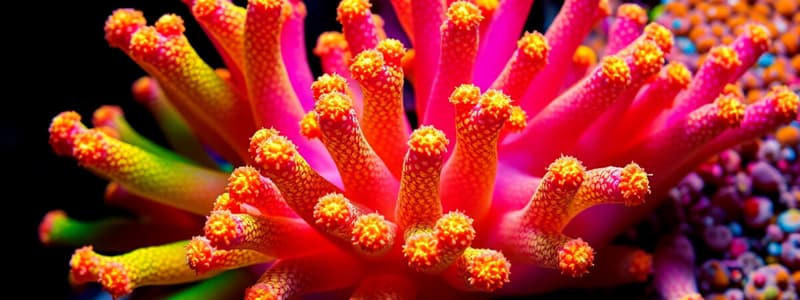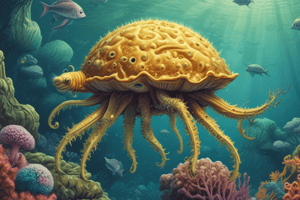Podcast
Questions and Answers
Larger sponges require greater ______ internal areas.
Larger sponges require greater ______ internal areas.
surface
Which of the following is NOT a grade of sponge body structure?
Which of the following is NOT a grade of sponge body structure?
- Syconoid
- Leuconoid
- Hexactinellida (correct)
- Asconoid
Sponges in the class Calcarea have spicules made of silica.
Sponges in the class Calcarea have spicules made of silica.
False (B)
What is the function of choanocytes in sponges?
What is the function of choanocytes in sponges?
Match the following classes of sponges with their distinguishing characteristics:
Match the following classes of sponges with their distinguishing characteristics:
The osculum is the ______ opening of a sponge, through which water exits.
The osculum is the ______ opening of a sponge, through which water exits.
All sponges belong to the class Demospongiae.
All sponges belong to the class Demospongiae.
What is the difference between megascleres and microscleres in sponges?
What is the difference between megascleres and microscleres in sponges?
Homoscleromorpha is a group of sponges that used to be classified within the ______.
Homoscleromorpha is a group of sponges that used to be classified within the ______.
What is the primary source of information for the phylogenetic analysis of Homoscleromorpha presented in the text?
What is the primary source of information for the phylogenetic analysis of Homoscleromorpha presented in the text?
Homoscleromorpha is a group of approximately 100 species.
Homoscleromorpha is a group of approximately 100 species.
Match the ecological importance of sponges with their respective functions:
Match the ecological importance of sponges with their respective functions:
What are two potential evolutionary relationships for Homoscleromorpha based on the text?
What are two potential evolutionary relationships for Homoscleromorpha based on the text?
Which of the following is NOT mentioned as a chemical defense produced by sponges?
Which of the following is NOT mentioned as a chemical defense produced by sponges?
The text mentions the mutualistic relationship between sponges and ______ where the sponge provides a habitat and the ______ provides transport for the sponge.
The text mentions the mutualistic relationship between sponges and ______ where the sponge provides a habitat and the ______ provides transport for the sponge.
The ancestral metazoan may have been similar to a sponge choanocyte.
The ancestral metazoan may have been similar to a sponge choanocyte.
The phylum Placozoa has no known ______
The phylum Placozoa has no known ______
Placozoa possess true tissues.
Placozoa possess true tissues.
What is the primary mode of digestion in Placozoa?
What is the primary mode of digestion in Placozoa?
Describe the body symmetry of Placozoa.
Describe the body symmetry of Placozoa.
The skeleton of Placozoa is composed of a ______ syncytium.
The skeleton of Placozoa is composed of a ______ syncytium.
Which of the following statements accurately describes the body symmetry of sponges?
Which of the following statements accurately describes the body symmetry of sponges?
Match the following terms with their corresponding descriptions:
Match the following terms with their corresponding descriptions:
Sponges are primarily ______ feeders.
Sponges are primarily ______ feeders.
All sponges are monoecious (hermaphroditic).
All sponges are monoecious (hermaphroditic).
Which of the following is NOT a major cell type found in sponges?
Which of the following is NOT a major cell type found in sponges?
Phylum Porifera is also known as "________________"
Phylum Porifera is also known as "________________"
What are the two main components of the skeletal structure of sponges?
What are the two main components of the skeletal structure of sponges?
Which of the following is NOT a characteristic of sponges?
Which of the following is NOT a characteristic of sponges?
Sponges are considered to be at the tissue level of organization.
Sponges are considered to be at the tissue level of organization.
Match the following terms with their respective definitions:
Match the following terms with their respective definitions:
What is the primary function of the cells in a sponge?
What is the primary function of the cells in a sponge?
Sponges have a true gut and a circulatory system.
Sponges have a true gut and a circulatory system.
Match the following terms to their correct definitions:
Match the following terms to their correct definitions:
The process of sponge reproduction where a fragment of the sponge breaks off and develops into a new sponge is called ______.
The process of sponge reproduction where a fragment of the sponge breaks off and develops into a new sponge is called ______.
Describe the function of choanocytes in sponges.
Describe the function of choanocytes in sponges.
Which of the following is NOT a type of asexual reproduction in sponges?
Which of the following is NOT a type of asexual reproduction in sponges?
Sponges that are ______ have separate sexes and produce either sperm or eggs.
Sponges that are ______ have separate sexes and produce either sperm or eggs.
Sponges have specialized cells that can change their function based on the needs of the organism.
Sponges have specialized cells that can change their function based on the needs of the organism.
Which of the following is a type of larval stage found in sponges?
Which of the following is a type of larval stage found in sponges?
What is the main difference between spicules and spongin in the sponge skeleton?
What is the main difference between spicules and spongin in the sponge skeleton?
Spicules are formed by specialized cells called ______.
Spicules are formed by specialized cells called ______.
Sponges can reproduce both sexually and asexually.
Sponges can reproduce both sexually and asexually.
Which of the following is a type of asexual reproduction in sponges that involves the formation of a resistant bud that can survive harsh conditions?
Which of the following is a type of asexual reproduction in sponges that involves the formation of a resistant bud that can survive harsh conditions?
Explain how sponges obtain food.
Explain how sponges obtain food.
Flashcards
Phylum Porifera
Phylum Porifera
A group of simple, multicellular animals known as sponges.
Poriferan Characteristics
Poriferan Characteristics
Porifera have no true tissue organization and are sessile, meaning they are fixed in one place.
Cell Aggregation
Cell Aggregation
Cells in Porifera are gathered together, maintaining structure without true tissues.
Intracellular Matrix
Intracellular Matrix
Signup and view all the flashcards
Embryonic Origin
Embryonic Origin
Signup and view all the flashcards
Phylum Placozoa
Phylum Placozoa
Signup and view all the flashcards
Known Species (2017)
Known Species (2017)
Signup and view all the flashcards
Body Symmetry
Body Symmetry
Signup and view all the flashcards
Tissue Grade
Tissue Grade
Signup and view all the flashcards
Digestion Method
Digestion Method
Signup and view all the flashcards
Reproduction Method
Reproduction Method
Signup and view all the flashcards
Lifestyle
Lifestyle
Signup and view all the flashcards
Development
Development
Signup and view all the flashcards
Homoscleromorpha
Homoscleromorpha
Signup and view all the flashcards
Ecological Importance of Sponges
Ecological Importance of Sponges
Signup and view all the flashcards
Predatory Sponges
Predatory Sponges
Signup and view all the flashcards
Chemical Defenses
Chemical Defenses
Signup and view all the flashcards
Mutualistic Interactions
Mutualistic Interactions
Signup and view all the flashcards
Origins of Multicellularity
Origins of Multicellularity
Signup and view all the flashcards
Monoecious
Monoecious
Signup and view all the flashcards
Choanocyte
Choanocyte
Signup and view all the flashcards
Dioecious
Dioecious
Signup and view all the flashcards
Sponge Defense Mechanisms
Sponge Defense Mechanisms
Signup and view all the flashcards
Suspension feeders
Suspension feeders
Signup and view all the flashcards
Choanocytes
Choanocytes
Signup and view all the flashcards
Spicules
Spicules
Signup and view all the flashcards
Spongin
Spongin
Signup and view all the flashcards
Asexual reproduction
Asexual reproduction
Signup and view all the flashcards
Gemmule
Gemmule
Signup and view all the flashcards
Water movement
Water movement
Signup and view all the flashcards
Reproductive cells
Reproductive cells
Signup and view all the flashcards
Skeletal formation
Skeletal formation
Signup and view all the flashcards
Parenchymula larvae
Parenchymula larvae
Signup and view all the flashcards
Cell specialization
Cell specialization
Signup and view all the flashcards
Osculum
Osculum
Signup and view all the flashcards
Ostium
Ostium
Signup and view all the flashcards
Class Hexactinellida
Class Hexactinellida
Signup and view all the flashcards
Class Calcarea
Class Calcarea
Signup and view all the flashcards
Class Demospongiae
Class Demospongiae
Signup and view all the flashcards
Leuconoid
Leuconoid
Signup and view all the flashcards
Syncytial
Syncytial
Signup and view all the flashcards
Study Notes
Porifera (Sponges)
- Phylum Porifera, also known as "pore bearers", are multicellular, aquatic animals
- Sponges lack true tissues and organs
- They have a cellular level of organization, where cells are loosely aggregated and perform specific functions
- They are mostly marine and entirely benthic
- They range from 5-10 thousand known species
- Reproduction is both sexual and asexual, with many species being hermaphroditic (monoecious)
- Some are gonochoristic (dioecious)
- Adult sponges are suspension feeders
- They feed on phytoplankton, small zooplankton, and bacteria
- Fossil forms date back as far as 750 million years ago
- Sponges lack a gut, circulatory system, body cavity, nervous system, organs, and have no symmetry
- Specialized water movement cells, including choanocytes
- Spicules are made of silica or calcium carbonate
- Spongin is a collagen-like protein that gives many sponges their structural support
Porifera Body Plan
- Water flow enters through pores (ostium)
- Water flows through channels (atrium)
- Water exits through a large opening (osculum)
- Choanocytes line the channels and create water current to filter food particles
- Specialized water movement cells in sponges are essential for their feeding and survival
Major Cell Types
- Choanocytes: collar cells, responsible for feeding and creating water movement
- Pinacocytes: flat cells that form the outer layer of the sponge
- Porocytes: tube-like cells that form pores in the sponge
- Archaeocytes: amoeboid cells that can differentiate into other cell types, including sclerocytes and spongocytes
- Sclerocytes: specialized cells that secrete spicules
- Spongocytes: specialized cells that secrete spongin fibers, providing further structural reinforcement for the sponge
Sponge Reproduction
- Asexual reproduction occurs through fragmentation and budding
- Gemmules are a specialized form of asexual reproduction in which internal buds (gemmules) are formed, each potentially capable of developing into a new sponge.
- When conditions are unsuitable, sponges release gemmules which can later develop
- Sexual reproduction involves the release of eggs and sperm, which can be released from the sponge and then taken up by other sponges for fertilization
- Further development results in a parenchymula larva that settles and develops into an adult sponge
Sponge Body Structure
- Three grades of body structure exist: asconoidea, syconoida, leuconoida
- Larger sponges exhibit a greater degree of internal complexity, reflecting their need for more extensive water flow systems for filtration of food
Sponge Spicules
- Spicules are made of either silica or calcium carbonate
- Provide structure support and defense against predators
Phylum Placozoa
- Approximately 20 species from the 1800s
- No tissues or organs
- They reproduce asexually by fission
- Mostly found in shallow coastal waters
- They exhibit a unique and simple body structure
- They have no true tissues or organs
- Body symmetry is asymmetrical
Additional information
- Sponges are important filter feeders and contribute to their environments' water quality
- Sponges serve as habitat for various other animals
- Some species of sponges have chemical defenses
Studying That Suits You
Use AI to generate personalized quizzes and flashcards to suit your learning preferences.




